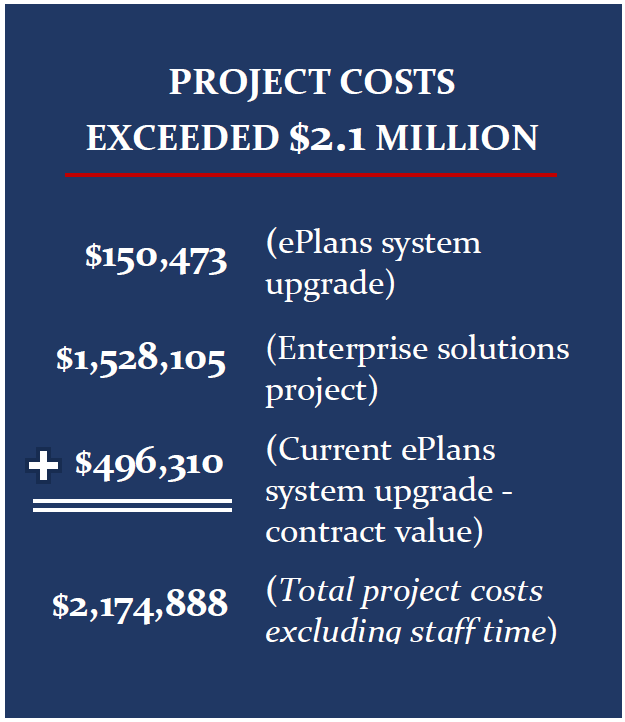By Adam Pagnucco.
Montgomery County Inspector General Megan Davey Limarzi has issued a new report detailing how the county’s Department of Permitting Services (DPS) attempted to implement a new enterprise system to replace four older ones. However, upon running into implementation problems and finding that the new system was inferior to the older ones, DPS junked it. The total cost to the county was $2.1 million.
Limarzi opens her report with this summary.
*****
The Montgomery County Office of the Inspector General (OIG) initiated this review to evaluate the Department of Permitting Services’ (DPS) efforts to procure and implement an enterprise system to manage a number of its core services.
In May 2021, DPS used a contract bridged from another public entity to procure a single enterprise software system with a projected cost of $4.5 million. This enterprise system was intended to replace four disparate systems DPS was using to manage and administer permits, licensing, inspections, and code enforcement activities.
From the outset, implementation of the new system presented numerous challenges. As the contract was bridged from another public entity, DPS had limited ability to customize processes or functionality. Some DPS staff lacked the expertise to migrate existing data into the new system and it became apparent that the new system provided less functionality than the legacy systems it was replacing. After spending approximately $2.1 million, the contract was terminated prior to implementation of the new system.
*****
Limarzi goes on to tell the story of what happened. DPS hired a new director in April 2020 “who was tasked with improving customer service and streamlining the permitting process.” This director then “decided to replace the four separate platforms with a single, cloud-based enterprise system.”
To expedite the process, DPS chose to use a bridged contract rather than to let a new one. The OIG elaborated, “In a bridged contract, the county relies on another public entity’s competitive procurement process to satisfy competition requirements. While this typically shortens the procurement timeline, it limits the county to ‘materially the same goods and services’ included in the bridged contract. This means most customizations, expansion of services, and upgrades outside of the contract originally bridged are not permissible.”
The OIG does not name the other public entity that originated the bridged contract.
The report provides this detail on subsequent events.
*****
In May 2021, the county signed a $4.5 million contract that was bridged from another government entity to procure an enterprise software system to manage permits, licensing, inspections and code enforcement for DPS. From the beginning, DPS staff struggled with the implementation of the new system. The bridged contract placed responsibility for much of the required data migration on DPS. However, DPS staff lacked the expertise to complete the work independently so outside contractors, with limited knowledge of DPS processes, were hired to assist. Additionally, although best practices suggest an interval between configuration and data conversion, DPS’s compressed project timeline meant these tasks had to be done in parallel. This meant that processes for the new solution were not fully developed when DPS staff were attempting to map the data into the new system.
As the project progressed, DPS staff determined the new enterprise system had less functionality than the legacy systems it was replacing. DPS staff expressed concern that the new system did not align with DPS’s current business processes and practices so they compiled a list of 28 specific concerns regarding the functionality of the new system. The vendor indicated a willingness to customize some of the functionality requested by DPS, however, due to the restrictions inherent in bridged contracts, optimal customization was not possible.
DPS found that the limitations of the new system, coupled with the aggressive project timeline, overwhelmed staff. The DPS director retired in December 2022 and shortly thereafter the county terminated the contract. In March 2023, the county signed a new $496,310 contract to again upgrade ePlans to minimize operational impact and ensure current system stability while efforts to address DPS’s needs are reassessed. As of July 2023, DPS had begun the process of drafting a request for proposal (RFP) for another enterprise permitting solution. All told, the failed attempt to implement a new system cost the county approximately $1.5 million, including payments to the vendor and expenses for contractors assigned to the project. This does not include the extensive amount of staff time spent preparing for the implementation of the new system.
*****
The OIG prepared the graphic below showing the total costs of the failed project.

The OIG recommended to the executive branch that they create a structured framework for enterprise solution procurements, restrict the use of bridge contracts for enterprise solutions and ensure functionality of current systems. Chief Administrative Officer Rich Madaleno concurred with the recommendations.
One detail not contained in the report is that three months after the DPS director retired, she was unanimously appointed to the Montgomery County Planning Board by the county council.
